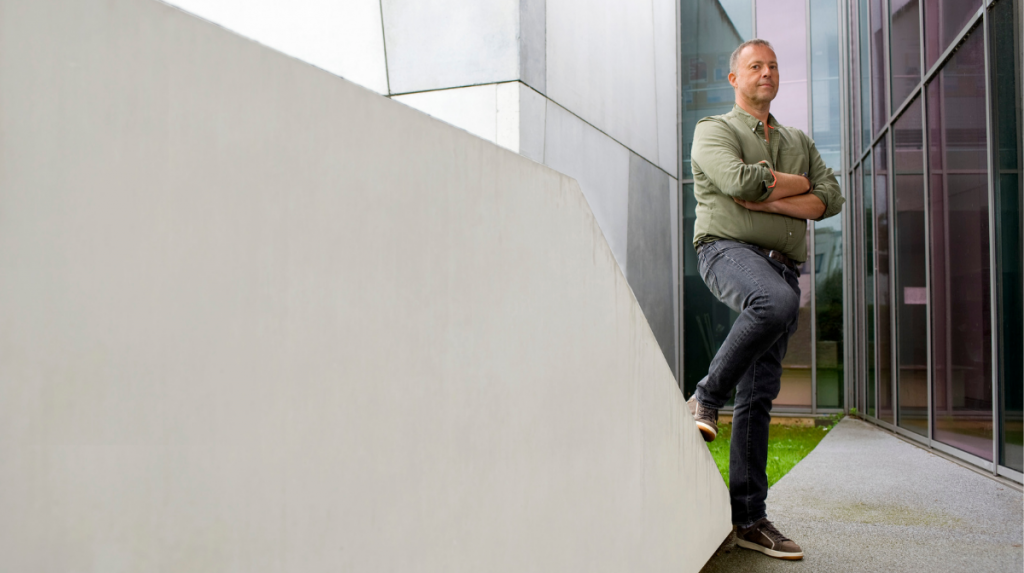With Denis Vivien, All Roads Lead to the Brain
From his beginnings in molecular biology to the neuroscience research conducted by his unit, Denis Vivien’s career has been remarkable. Curious and determined, he has never ceased to set up research projects and structures at the cutting edge of innovation and he has been entrusted with numerous academic responsibilities. Today, his fundamental discoveries on the role of the protease tPA in the central nervous system promise to improve the management of diseases such as stroke and multiple sclerosis.

Denis Vivien did not set out to become a neuroscientific researcher. « I began my university education with a diploma in marine biology, he says with the utmost seriousness. My ambition was to farm scallops. » In the end, the student left Caen for Rennes, and opted for research in molecular biology. « I wanted to join Université d’Orsay and become a researcher in genetic engineering, » he adds. It was there that he defended his dissertation in 1992, which looked at the effects of transforming growth factor beta (TGF‑β) on cartilage. Present in abundance in the skeleton, TGF‑β influences the regulation of immune response and inflammation, as well as cell proliferation, differentiation, and apoptosis. It is particularly implicated in certain cancers and bone diseases. The project led the researcher to New York where he did his post-doctorate at the Sloan Kettering Cancer Center. « Joan Massagué was the ‘high priest’ of TGF‑β at Sloan Kettering,he remembers. In order to meet him, I registered for a congress in the USA, suggesting that he come see my poster – which convinced him. »
After his return to France, this researcher with a strong temperament left his laboratory in Caen and joined the Cyceron1 medical imaging center to conduct brain studies there. « I knew that the brain was located between the ears, but that was about it, he says. We bought the first pipettes from Cyceron and with neuroscientist Alain Buisson2 we embarked on a project looking at TGF‑β and excitotoxicity, a process of neural destruction. » The researchers published several original articles on the topic and Vivien was made Professor of Neuroscience « … despite having never done a course in it! » jokes the man who keeps reminding his students that legitimacy is acquired through scientific curiosity. « During a career, it is possible to read and learn. »
In 2002, Vivien weighed anchor once again to launch his own laboratory, with the support of the Avenir-Inserm program and Christian Bréchot, then CEO of the Institute. He submitted an application to this program that supports very high-level innovative projects. « I was aware that if I failed I would have to take to the open sea. But my project was selected. » The team, set up in 2005, consisted of five people. Sixteen years later, it is now an internationally-recognized Inserm unit of 140 members. Its discoveries have been exceptional, particularly in relation to tissue plasminogen activator (tPA), a protease: it cleaves other proteins and renders them active. « It’s my favorite molecule, » says Vivien, who is studying its function within both the vascular and central nervous systems. In the latter, it acts on the ability of synapses to modulate the transmission of the electrical signal from one neuron to another – a phenomenon known as synaptic plasticity.
From bench to bedside
At the vascular level, the researchers revealed that tPA interacts with the NMDA (N‑methyl-D-aspartate) receptor, a glutamate receptor involved in communication between cells. This is a major discovery in the fight against stroke: used in the clinical setting, the harmful effects of tPA – neural death, inflammation, hemorrhage – are harnessed to dissolve blood clots. Vivien’s laboratory, having shown that tPA modulates the action of the NMDA receptors, is now trying to counter the harmful effects of the protease using new diagnostic or therapeutic tools. A clinical development program using immunotherapy, under license (Glunozumab®), is underway.
The research led by Vivien thus goes beyond the framework of fundamental research. “We navigate more and more with clinicians, he notes. There is no shortage of clinical applications, and we are promoting them through start-ups and industrial partnerships. This is what led us to create the Blood & Brain Caen Normandie (BB@C) scientific interest group. » Inserm, Université de Caen Normandie and Caen Normandy University Hospital are its founding members. Clinical trials stemming from the laboratory’s work are ongoing, and several Inserm patents have been filed. Two start-ups have been created, one being Op2Lysis, which promotes a patent for a tPA molecule optimized against intracerebral hemorrhage. The other is Lys Therapeutics – whose scientific board is chaired by Vivien – which won the i‑Lab 2021 major innovation competition for the antibody it is developing against neurotoxicity and brain inflammation that targets the NMDA receptor to block its interaction with tPA. The proliferation of public-private partnerships pleases the researcher: « I find it interesting to combine fields I do not know, to bring together various areas of expertise: biologists, chemists… all federated around a subject that is not the exclusive expertise of any one person. And there is no shortage of projects! »
Notes:
1: unit 1237 Inserm/Université Caen Normandie 2: unit 1216 Inserm/Grenoble Institute of Neuroscience
